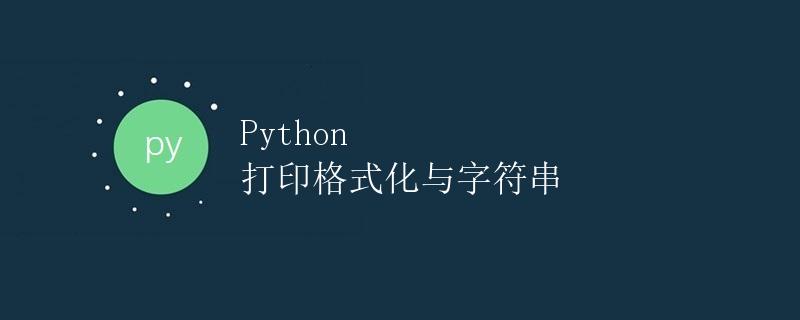Python 打印格式化与字符串

1. 引言
在 Python 编程中,经常需要打印输出数据结果或处理字符串。Python 提供了多种打印格式化的方法和字符串操作函数,能够帮助我们更好地处理和展示数据。本文将详细介绍 Python 的打印格式化和字符串操作方法,帮助读者更好地理解和应用这些技巧。
2. 打印格式化
2.1 使用 print() 函数打印基本数据类型
在 Python 中,使用 print() 函数可以打印基本数据类型值,如整数、浮点数和字符串等。
示例代码如下:
num = 10
print(num) # 输出整数类型值
float_num = 3.14
print(float_num) # 输出浮点数类型值
name = "Alice"
print(name) # 输出字符串类型值
输出结果:
10
3.14
Alice
2.2 格式化字符串输出
除了直接打印基本数据类型的值,Python 中还提供了格式化输出的方法。常用的格式化输出方法有以下几种:
2.2.1 使用格式化字符串
在格式化字符串中,可以使用占位符 % 来表示需要被替换的部分。常用的占位符有以下几种:
%d: 整数类型%f: 浮点数类型%s: 字符串类型
示例代码如下:
age = 20
print("My age is %d" % age) # 格式化输出整数类型
pi = 3.1415
print("The value of pi is %f" % pi) # 格式化输出浮点数类型
name = "Alice"
print("My name is %s" % name) # 格式化输出字符串类型
输出结果:
My age is 20
The value of pi is 3.141500
My name is Alice
2.2.2 使用 format() 方法
Python 还提供了 format() 方法进行字符串格式化输出。在使用 format() 方法时,可以使用大括号 {} 来表示需要被替换的部分。
示例代码如下:
age = 20
print("My age is {}".format(age)) # 使用 format() 方法格式化整数类型
pi = 3.1415
print("The value of pi is {:.2f}".format(pi)) # 使用 format() 方法格式化浮点数类型
name = "Alice"
print("My name is {}".format(name)) # 使用 format() 方法格式化字符串类型
输出结果:
My age is 20
The value of pi is 3.14
My name is Alice
2.2.3 使用 f-string
从 Python 3.6 开始,还可以使用 f-string 进行字符串格式化输出。在 f-string 中,可以直接在字符串中插入表达式和变量,并使用大括号 {} 来表示需要被替换的部分。
示例代码如下:
age = 20
print(f"My age is {age}") # 使用 f-string 格式化整数类型
pi = 3.1415
print(f"The value of pi is {pi:.2f}") # 使用 f-string 格式化浮点数类型
name = "Alice"
print(f"My name is {name}") # 使用 f-string 格式化字符串类型
输出结果:
My age is 20
The value of pi is 3.14
My name is Alice
2.3 打印对象
除了基本数据类型的打印格式化,还可以对自定义的对象进行格式化输出。在 Python 中,可以通过定义 __str__() 或 __repr__() 方法来为对象提供自定义的打印格式。
示例代码如下:
class Person:
def __init__(self, name, age):
self.name = name
self.age = age
def __str__(self):
return f"Person: {self.name}, {self.age} years old"
def __repr__(self):
return f"Person('{self.name}', {self.age})"
p = Person("Alice", 20)
print(p) # 自动调用 __str__() 方法
print(repr(p)) # 自动调用 __repr__() 方法
输出结果:
Person: Alice, 20 years old
Person('Alice', 20)
3. 字符串操作
3.1 字符串拼接
在 Python 中,可以使用 + 运算符来进行字符串拼接。
示例代码如下:
str1 = "Hello"
str2 = "World"
result = str1 + ", " + str2
print(result)
输出结果:
Hello, World
3.2 字符串分割
Python 中提供了 split() 方法来分割字符串。可以指定分隔符,并返回一个包含分割后的子字符串的列表。
示例代码如下:
str = "Hello,World"
result = str.split(",")
print(result)
输出结果:
['Hello', 'World']
3.3 字符串替换
Python 字符串还提供了 replace() 方法来替换指定的字符或子字符串。
示例代码如下:
str = "Hello,World"
result = str.replace("World", "Alice")
print(result)
输出结果:
Hello,Alice
3.4 字符串大小写转换
Python 字符串可以使用 lower() 方法将字符串转换为小写,使用 upper() 方法将字符串转换为大写。
示例代码如下:
str = "Hello,World"
result1 = str.lower() # 转换为小写
result2 = str.upper() # 转换为大写
print(result1)
print(result2)
输出结果:
hello,world
HELLO,WORLD
4. 结论
本文介绍了 Python 打印格式化和字符串操作的方法。通过使用合适的打印格式化方法和字符串操作函数,可以更好地处理和展示数据。
 极客教程
极客教程